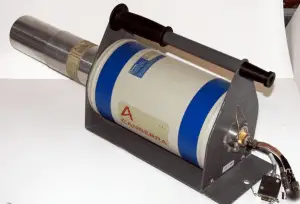
A semiconductor detector is a radiation detector based on a semiconductor, such as silicon or germanium, to measure the effect of incident charged particles or photons. Semiconductor detectors are widely used in radiation protection, an assay of radioactive materials, and physics research because they have some unique features, can be made inexpensively yet with good efficiency, and can measure both the intensity and the energy of incident radiation. These detectors are employed to measure the energy of the radiation and for the identification of particles. Of the available semiconductor materials, silicon is mainly used for charged particle detectors (especially for tracking charged particles) and soft X-ray detectors. In contrast, germanium is widely used for gamma-ray spectroscopy. A large, clean, and almost perfect semiconductor is ideal as a counter to radioactivity. However, it isn’t easy to make large crystals with sufficient purity. The semiconductor detectors have low efficiency but give a very precise measure of energy. Semiconductor detectors, especially germanium-based detectors, are most commonly used where a very good energy resolution is required. The detectors must operate at very low temperatures of liquid nitrogen (-196°C) to achieve maximum efficiency. Therefore, the drawback is that semiconductors are much more expensive than other detectors and require sophisticated cooling to reduce leakage currents (noise).
Advantages and Disadvantages of Semiconductor Detectors
Advantages of HPGe Detectors
- Higher atomic number. Germanium is preferred because its atomic number is much higher than silicon, which increases the probability of gamma-ray interaction.
- Germanium has lower average energy necessary to create an electron-hole pair, which is 3.6 eV for silicon and 2.9 eV for germanium.
- Very good energy resolution. The FWHM for germanium detectors is a function of energy. For a 1.3 MeV photon, the FWHM is 2.1 keV, which is very low.
- Large Crystals. While silicon-based detectors cannot be thicker than a few millimeters, germanium can have a depleted, sensitive thickness of centimeters and, therefore, can be used as a total absorption detector for gamma rays up to a few MeV.
Disadvantages of HPGe Detectors
- Cooling. The major drawback of HPGe detectors is that they must be cooled to liquid nitrogen temperatures. Because germanium has a relatively low band gap, these detectors must be cooled to reduce the thermal generation of charge carriers to an acceptable level. Otherwise, leakage current-induced noise destroys the energy resolution of the detector. Recall that germanium’s band gap (a distance between valence and conduction band) is very low (Egap= 0.67 eV). Cooling to liquid nitrogen temperature (-195.8°C; -320°F) reduces thermal excitations of valence electrons so that only a gamma-ray interaction can give an electron the energy necessary to cross the band gap and reach the conduction band.
- Price. The disadvantage is that germanium detectors are much more expensive than ionization chambers or scintillation counters.
Advantages of Silicon Detectors
- Compared with gaseous ionization detectors, the density of a semiconductor detector is very high, and charged particles of high energy can give off their energy in a semiconductor of relatively small dimensions.
- Silicon has a high density of 2.329 g/cm3, and the average energy loss per unit of length allows for building thin detectors (e.g., 300 µm) that still produce measurable signals. For example, in the case of a minimum ionizing particle (MIP), the energy loss is 390 eV/µm. The silicon detectors are mechanically rigid, so no special supporting structures are needed.
- Silicon-based detectors are very good for tracking charged particles, and they constitute a substantial part of the detection system at the LHC in CERN.
- Silicon detectors can be used in strong magnetic fields.
Disadvantages of Silicon Detectors
- Price. The disadvantage is that silicon detectors are much more expensive than cloud or wire chambers.
- Degradation. They also suffer degradation over time from radiation. However, this can be greatly reduced thanks to the Lazarus effect.
- High FWHM. In gamma spectroscopy, germanium is preferred due to its atomic number being much higher than silicon, increasing the probability of gamma-ray interaction. Moreover, germanium has lower average energy necessary to create an electron-hole pair, which is 3.6 eV for silicon and 2.9 eV for germanium. This also provides the latter with a better resolution in energy.